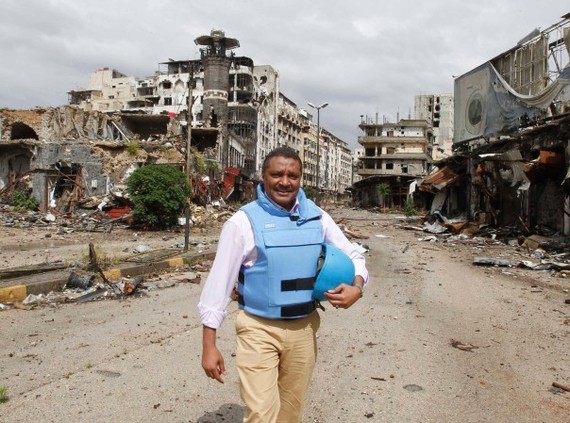The rubble of modern Syria lies on top of ancient civilizations that brought agriculture and the first phonetic alphabet to the world. Millennia later, Syria's people have been reduced to destitution. 9.6 million of the country's pre-war population of 23 million people have become displaced internally or have left altogether and are now refugees driven by a ruthless conflict that has claimed over 190,000 lives since it erupted in 2011. Three out of four remaining Syrians now live in poverty. Syria's human development indicators have regressed by 40 years since the conflict started.
The crisis in Syria has unleashed political and armed forces in the region that will take years to stabilize and neutralize. In the wholesale destruction of some of its towns and cities, the war has also decimated one of the world's cradles of civilization. The plight of ordinary Syrians -- the true casualties of this war -- seems to have receded from the public imagination amid internationally backed military operations here.
For almost four years, civil unrest, human rights breaches and armed violence have been the reality for children and their families. International humanitarian law is continuously violated. As families break up and lose contact with their loved ones, as children go hungry, as the sick go untreated, as boys and girls go without education, the fabric of Syria is being torn apart. This will have unimaginable consequences on the long-term stability of the region.
Every day humanitarian workers -- over sixty of whom have lost their lives since the conflict erupted, most being Syrian Arab Red Crescent volunteers -- face risks and threats to their lives. Thanks to these unsung heroes, the United Nations and its partners are able to reach millions of people and deliver urgently needed humanitarian aid. For example, food assistance was provided to 4.15 million Syrians in August this year, out of a targeted group of 4.25 million. Health care was delivered to 6.5 million direct beneficiaries while 2.9 million children under the age of five were vaccinated against polio.
When the Security Council adopted Resolution 2165 last July, it enabled UN humanitarian agencies to deliver humanitarian aid across the border for the first time. The combined efforts of UN agencies and partners, coupled with efforts by some of the major international non-governmental organizations which have been delivering cross border humanitarian aid for more than two years, is making it possible to reach a greater number of civilians and deliver urgently needed humanitarian assistance.
But just as we achieved this important milestone, the funding started drying up. Even as a meagre portion of humanitarian aid is trickling in, global attention and resources have shifted to dealing with the threat of ISIL. By contrast, experts estimate the cost of international military intervention in the region to easily run into the billions of dollars every year. Each missile costs about $1.5 million and the F-22 jets cost roughly $68,000 an hour to fly.
Almost 11 million people in Syria are in need of assistance. Of this number, the UN estimates that as the winter approaches over 3 million will require urgent assistance, including warm clothing, blankets and fuel for heating totaling $113 million. Families in extreme poverty will be left to eat only bread, and sleep without heating and blankets. Basic health needs will not be met and children will have to stop going to school. Meanwhile, the crisis has led to a significant decrease in vaccinations of children and the re-appearance of diseases, such as Polio, fourteen years after it was eradicated in Syria.
Until recently, Syria was the world's third largest refugee hosting country -- coming only after Pakistan and Iran -- with no less than a million refugees who came to Syria seeking safety and sanctuary. Today, with the UN Refugee Agency (UNHCR) marking the three millionth Syrian refugee registered in a neighboring country, Syrians are sadly the number one nationality in the world with the highest number of asylum applications. And yes there is donor fatigue when the latest developments show the country being sucked into a vortex of violence and despair.
Humanitarian assistance costs money, especially when the scale of the humanitarian problem is as catastrophic as it is in Syria. It is vital and it saves lives. But clearly aid is only part of the equation. The international community must work with the parties to find a political solution to end this crisis. The world cannot afford to push aside the suffering of the Syrian people. An entire generation shaped by violence, displacement and a rollback of prosperity and development is a cataclysmic disaster -- for Syria, the region and the world.
_________________
The author, Yacoub El Hillo, is the UN Resident and Humanitarian Coordinator in Syria, based in Damascus.

